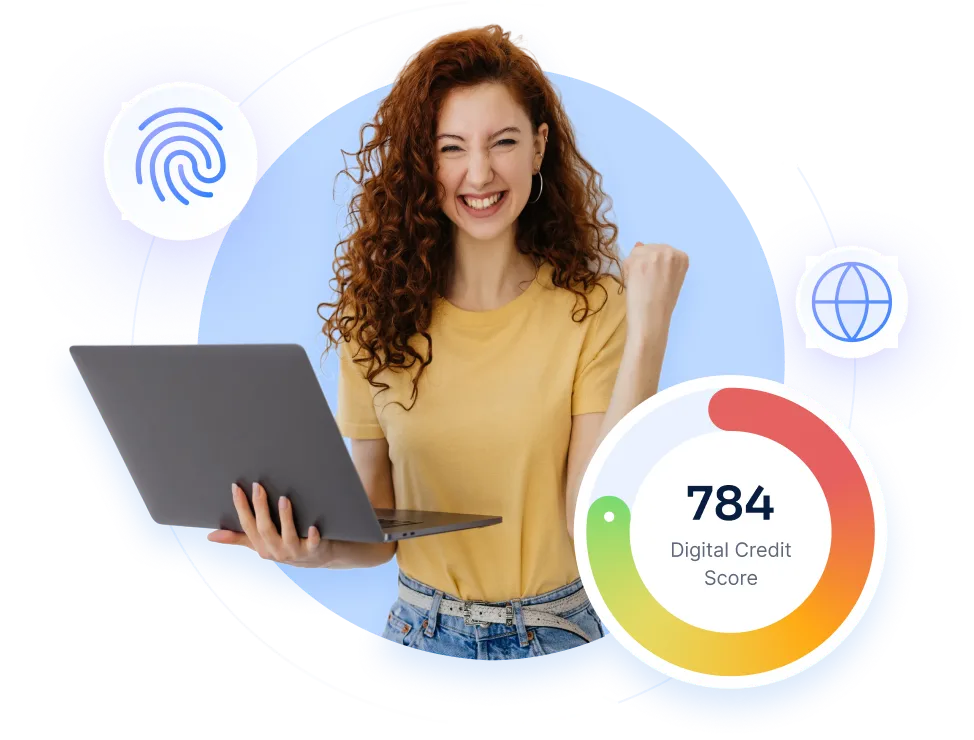The Top 10 Credit Scoring Trends That Will Reshape the Future of Lending
Stay up to date with upcoming trends in the digital credit scoring industry.

Traditional credit scoring methods have stood the test of time and have long shown good results in assessing the creditworthiness of potential borrowers.
However, as the world embraces digital transformation, the credit scoring market assessment is also changing.
Let’s discuss how credit scoring is evolving and what lies ahead for the industry in the near future.
The rise of modern credit scoring software is reshaping how lenders assess borrower reliability. And it goes far beyond traditional models.
#1. Using alternative data for credit scoring
Alternative data sources include social media activity, utility bills, rental payments, and more. They can provide online lending organizations with much more information than traditional sources. Like credit history and scores.
For example, data on mobile usage can help reach the widest possible audience for lending services.
According to Statista analysis, there are currently around 4.9 billion smartphone users worldwide. By 2029, this figure is projected to increase to 6.4 billion. This trend is depicted in the diagram below:
.webp)
Each smartphone user leaves up to 188 digital traces daily. So, it becomes clear how much data can be obtained from non-traditional sources.
The trend implementation at RiskSeal
RiskSeal identifies 400+ digital footprints of users by analyzing over 200 social and digital platforms. We also look at phone numbers, emails, and IP addresses.
We enrich our clients' credit models with alternative data. This allows them to expand their target audience and make informed decisions about credit applications.

#2. Machine Learning (ML) in credit assessment
Machine learning algorithms can predict the likelihood of default based on complex patterns unavailable to human analysts. Additionally, such algorithms are more adaptive as they can learn from new data.
Another advantage of using this progressive technology in credit scoring is the ability of ML to process large datasets.
They can analyze information from various sources. This may include data from Buy Now, Pay Later (BNPL) services, geodemographic data, current inquiries, etc.
The trend implementation at RiskSeal
RiskSeal employs ML technology in its models. We understand how challenging it can be to use non-traditional data in credit analysis.
Therefore, we provide ready-to-use machine learning and risk analysis functions and data in the required format for integration into the model.
Let's consider the email lookup function as an example. At RiskSeal, we can provide a lot of additional information about an email address.
Was it created on a free service or a corporate email? Does it contain the consumer's name and surname? Is it deliverable?

#3. Explainable Artificial Intelligence (AI) in finance
The global AI market in the fintech sector was valued at $12.32 billion in 2023. It is projected to grow at a CAGR of 15.5% in the coming years, and by 2032, its size will reach $45.07 billion.
This statistic shows that the level of technology utilization is rapidly increasing. More and more lenders, consumers, and regulatory bodies want assurances of fairness, ethics, and impartiality in AI-driven decisions.
AI can be a kind of "black box" receiving information about the borrower.
After analyzing the information, the AI system decides whether granting a loan is feasible. It does not provide any details about the reasons for such a decision.
Explainable AI in credit risk management can help solve this situation. This technology allows people to understand and trust the system's decisions.
Thus, credit scoring becomes transparent, and user engagement increases.
The trend implementation at RiskSeal
At RiskSeal, we recognize the importance of such an approach to credit assessment. So, we explain the decisions made to lenders.
Our API provides digital credit scoring as a formula, thereby eliminating any bias.

In addition to the original data, we provide our clients with a list of metrics characterizing the inclinations of potential borrowers.
These include Solvency, Gambler, Shopper, etc. Thanks to such specificity, the lender understands why a particular decision was made regarding each borrower.
#4. Financial inclusion for “credit invisible” individuals
Traditional data cannot fully meet the needs of modern lending. The issue is that traditional credit scoring models only analyze borrowers' credit histories.
This means that over 1.4 billion unbanked people worldwide may not be able to access credit, although they are likely creditworthy.
New models are being developed to assess creditworthiness based on alternative data so that people who are “invisible” to the credit system can gain access to credit.
The trend implementation at RiskSeal
RiskSeal is a solution capable of effectively assessing the creditworthiness of clients without a credit history.
We analyze users' online behavior and gather hundreds of digital footprints. This is how we make decisions regarding the possibility of extending credit based on this information.

#5. Behavioral data analysis in lending
In addition to financial information, many modern scoring models consider consumers' behavioral patterns. These could be shopping habits or online viewing statistics.
As digital lending trends evolve, this type of behavioral insight helps assess financial literacy and predict defaults.
The trend implementation at RiskSeal
User behavior analysis is one of the data sources used in RiskSeal. We analyze data on subscriptions, interaction with financial websites, and responses to financial products.
In practice, this looks like this: if we see that a potential borrower regularly pays for subscriptions like Spotify, Disney+, or Netflix, it shows their financial stability.

#6. Personalized approach to each client
A one-size-fits-all approach to lending needs to be updated. Today, lending technology trends drive more lenders to offer individualized terms based on each client’s rating.
NerdWallet shows that the difference in interest rates for online consumer loans, depending on the borrower's reliability, can reach up to 9%:
Lending organizations can optimize profitability and increase customer satisfaction by using this approach.
The trend implementation at RiskSeal
RiskSeal offers its clients comprehensive borrower insights to tailor credit offers. Fintechs receive detailed behavioral data, including shopping, travel, and technology preferences.
For instance, RiskSeal can reveal if a potential borrower regularly uses specialized websites for booking transport or accommodations.
This enables lending organizations to specifically offer travel loans or insurance products.

#7. Expansion of data analytics professionals' skills
This trend is closely linked to the growing volume of detailed data in the credit rating software market.
Working with them will require data analytics professionals to acquire new competencies. These include critical thinking, communication skills, and the ability to visualize.
The ability to link complex technical concepts with business outcomes is critical for the new generation of professionals.
Lending organizations will value Chief Data Officers (CDO) and Chief Analytics Officers (CAO) with expertise in fintech credit risk, data interpretation, and compliance.
The trend implementation at RiskSeal
RiskSeal is a reliable data source for such professionals. We assist in integrating data into scoring models and interpret them.
Our clients can also rely on consultations when working with enriched scoring models.
#8. Instant application review with digital-first solutions
Forecasts predict that the global FinTech market will reach $556.58 billion by 2030, demonstrating a CAGR of 19.5% over the next six years:

Rapid development is also projected for non-banks. The latest research shows that their annual growth rate in the coming years will be 54.8%, with the market size reaching $66.8 billion by 2030.
As credit risk digital transformation accelerates, lenders are seeking more advanced digital solutions for credit scoring.
This software is expected to provide nearly instant results in reviewing credit applications. Such products will enhance customer service quality by accelerating the loan approval process.
The trend implementation at RiskSeal
RiskSeal fully supports such trends in digital lending, providing actionable scores in less than 5 seconds per applicant.
This ensures a positive user experience for borrowers and increased profitability for lending organizations.
#9. Bias reduction in credit scoring
Manual underwriting is prone to mistakes due to human factors and bias in application decision-making.
This can result in borrowers being charged unjustifiably high-interest rates or being denied credit altogether.
Lending organizations also face the risk of extending credit to potential defaulters or losing reliable customers.
Digital products based on AI address these problems. ML algorithms eliminate bias and reduce the number of mistakes in reviewing credit applications.
They analyze information about borrowers, identify patterns, and provide transparent and fair decisions.
The trend implementation at RiskSeal
At RiskSeal, we understand the importance of bias reduction in credit scoring. To achieve this goal, we:
- Use AI-based credit risk assessment.
- Provide clients with digital credit scoring in the form of a formula.
- Enrich scoring models with alternative data, including behavioral criteria.
#10. Optimization of credit ratings through open banking
Consumers are now more willing to share their financial information with lending organizations due to the rise of digital technologies.
They recognize that by providing access to their data, brands can offer personalized solutions more relevant to their needs.
One of the modern credit scoring trends is the concept of Open Banking, which involves the use of open APIs in the financial environment.
Information about banking transactions and similar data helps to get a more stable and accurate credit rating.
This allows borrowers to obtain more favorable loan terms.
The trend implementation at RiskSeal
The Digital Footprint presented by RiskSeal is a rich source of information that is already available to every real customer. The solution analyzes a borrower's online presence, financial information, and behavioral patterns.
This serves as an excellent indicator of their creditworthiness. It lets you create an objective credit rating and lets borrowers take advantage of favorable loan conditions.
Risk managers wondering how to stay up-to-date on the latest credit risk trends should keep an eye on the digital shifts transforming everything from credit scoring to loan recovery.

Download Your Free Resource
Get a practical, easy-to-use reference packed with insights you can apply right away.

Download Your Free Resource
Get a practical, easy-to-use reference packed with insights you can apply right away.




FAQ
How do Machine Learning algorithms improve the credit scoring process?

Machine Learning algorithms predict the probability of default based on complex patterns identified by analyzing vast data sets. They continuously adapt by learning from new data, ensuring an objective decision on credit applications.
How does alternative data benefit those with limited credit history?

Traditional credit scoring relies solely on borrowers’ credit history for evaluation, leaving “credit invisible” individuals unable to access credit through this method. The use of alternative credit scoring allows lending to such consumers.
Additionally, scoring models enriched with alternative data help establish an objective credit rating, granting consumers access to more favorable loan terms.
How does RiskSeal identify creditworthy individuals without a credit history?

RiskSeal analyzes over 300 digital footprints of users by examining over 140 social and digital platforms. The solution also considers users' behavioral patterns and financial habits when compiling scoring models.
What is behavioral data, and how is it used in credit scoring?

Behavioral data refers to information about an individual's actions, decisions, and interactions over a specific period. Credit scoring can include online viewing statistics, shopping habits, credit card usage patterns, etc.
This information helps evaluate a consumer's financial status based on their online behavior. For example, regularly making payments for various subscription services could be viewed positively.
How can RiskSeal's data suggest specific financial products to consumers?

RiskSeal tracks consumers' online activities, analyzes this data, identifies patterns, and makes decisions based on them. For example, if a client frequently books international flights, a lending organization may offer them a travel loan or a credit card with travel rewards.
How does RiskSeal support data analytics professionals?

Access to quality data sources is important for data analytics professionals. The RiskSeal solution provides this access. We enrich our clients' scoring models with alternative data, assist in their interpretation, and provide ongoing consultations during the integration process and subsequent use.

.svg)

.webp)



